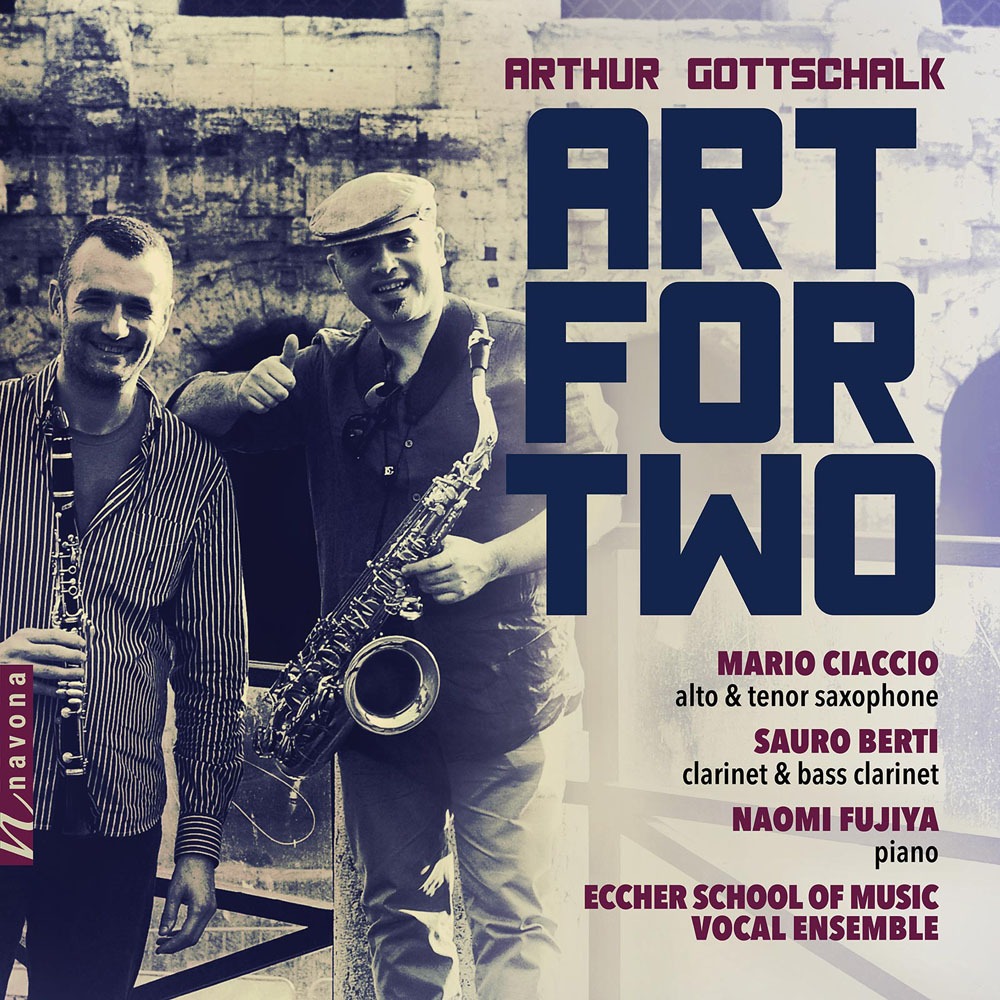
ART FOR TWO: Ciaccio and Berti play Gottschalk
Originally Published By: Fanfare Magazine
“Art for Two” is the title of a new Navona CD containing performances of the music by Amercan composer Arthur Gottschalk by Italian saxophonist Mario Ciaccio and his compatriot, clarinetist Sauro Berti. I was delighted to be able to interview these two gifted performers on their exploration of the music of a composer whose music I had not previously encountered, but provided me much enjoyment. I posed my questions to Ciaccio in September, 2018, and also addressed one to the chorus.
It is a bit unusual for two Italian musicians to release an entire disc of music by an American composer, who I am guessing from his name has no Italian blood running through his veins! How did you discover his music? What led you to record an entire CD devoted to it?
I met Arthur during one of my US tours in 2009, but after that first contact, I was still in Italy and asked him to send me his saxophone compositions. Later on, during my visit to Rice University for a concert, we had the idea for a revision of the Saxophone Sonata that you can hear on this CD. In 2011, he invited my pianist and me to give a concert in Houston 2011 where we rehearsed and premiered the revised version of the Alto Saxophone Sonata. I have also met him in Italy on two occasions. Arthur loves Italy, and during his trip in my country we made plans for dinner and even entire days to spend together.
The idea of recording an entire CD of Arthur’s music came to both Sauro and me because we love his style and we have both played his music separately in the past. We consider our profession as a journey between different styles. So, why not? It has been a nice journey to get inside the musical mind of this composer whom we consider to be among the most interesting in the American panorama. Finally, we are both friends of Arthur and this has created a magical bond between us.
I’m sure Fanfare readers will be interested in your musical background, and how you came to meet each other and begin playing together.
I studied saxophone in Italy and France and actually I played in the National Police Wind Orchestra. Personally I aim to enhance my experience not only with music but also with art and various languages. In fact, I have a Masters Degree in orchestral conducting but I have also studied Chinese, English, and French, and beginning this year, Arabic. I love the study of painting as well. For me, this is a special mix of interests because each of them helps me to communicate. I actually met Sauro through Arthur Gottschalk! In fact, Arthur first spoke of Sauro to me during one of my visits to his home in Houston and he put me in touch with Sauro immediately! I remember his words at that time, “Mario you have to know one special person in Rome, the great clarinet player Sauro Berti.” So, it was an introduction of two Italians to each other by an American!
Fascinating! Were any of the works on this disc composed for you specifically?
Oh more or Less was composed during one of Arthur’s Italian artist residencies as composer in Genova. Also, Shalom (that I love so much) was composed for us.
I would guess that there are not many works for the combination of a member of the saxophone family and a member of the clarinet family. What works for this combination by other composers have you performed together?
There are not so many older compositions for this ensemble, but in recent years, a good number of contemporary composers have written works for saxophone and clarinet. During our concerts or simply trying to discover new music we have played and tried out a lot of new music and we are continuing to ask for new works, especially from Italian composers. Maybe in the future a new all-Italian CD ? Probably!
Mario, you have had much international experience in countries such as the US, Taiwan, and Russia. How has this affected your musical outlook? Is there much difference in the schools of saxophone playing in these three countries (along with that in Italy)?
I love so much to sense the “smell” of different styles on playing saxophone around the world! Of course, my journeys have influenced my musicianship with ever new colors. Usually when I visit a new country, I try to play in my concert there one composition from one of their own composers. This allows me to discover and absorb new styles. I consider this to enhance the richness of every musician. Concerning the School of saxophone playing in different countries I have visited, yes, there are a number of differences. I think these are related to the cultural background of a particular country, traits which also influence the musical production and repertory. However, technically there are not so many differences, because all of the classical schools of saxophone evolved from the French school.
I also note your experience as a juror on several saxophone competitions, including the prestigious Adolphe Sax International Competition. What do you look for from the competitors in these events? Is there something definable that you hear in a participant that sets him or her off from the other contestants?
Being a member of a Jury for a competition is a great personal experience, because is the other side of the mirror, so to speak. This provides an opportunity for a player to consider how he wants a particular piece of music—or even the saxophone itself—to be played. I find it a considerable challenge to choose one player over another, but I do attempt to select the musician that demonstrates the best skill in communication and exhibits the most personal style. For me it is not important to listen for a perfect machine-like performance and not consider style, personal ideas, and something new that a contestant brings to the traditional repertory that all saxophonists know. The challenge in established pieces is to find something new that others cannot find.
In regard to the present CD, what were some of the musical or technical challenges that you found in these works?
To play Arthur’s music is always a challenge, for at any moment you can find Bach, Rock and Roll, Ravel, Frank Sinatra and Stravinsky! The performer of his music is required to be an actor who continuously changes his costume. It is like being in a great concert hall of a very colorful musical amusement park.
In regard to technical skills, I think Arthur knows my instrument very well, so he incorporates in his music the best natural solutions to play the very difficult passages.
And I have a question for the Eccher School of Music Vocal Ensemble: What were the challenges that you found in this unusual work with saxophone and clarinet accompaniment, in place of the usual piano or organ?
The role of the tenor sax and bass clarinet isn’t accompaniment, of course. The alternation between instruments and choir created a musical dialog the has enhanced the characteristic of each part of the ensemble. The result was a really great and new sonic effect.
– David Deboor Canfield
Related Articles
- April 17, 1994
Recent Articles
Upcoming Events
Upcoming Events
- There are no upcoming events.

